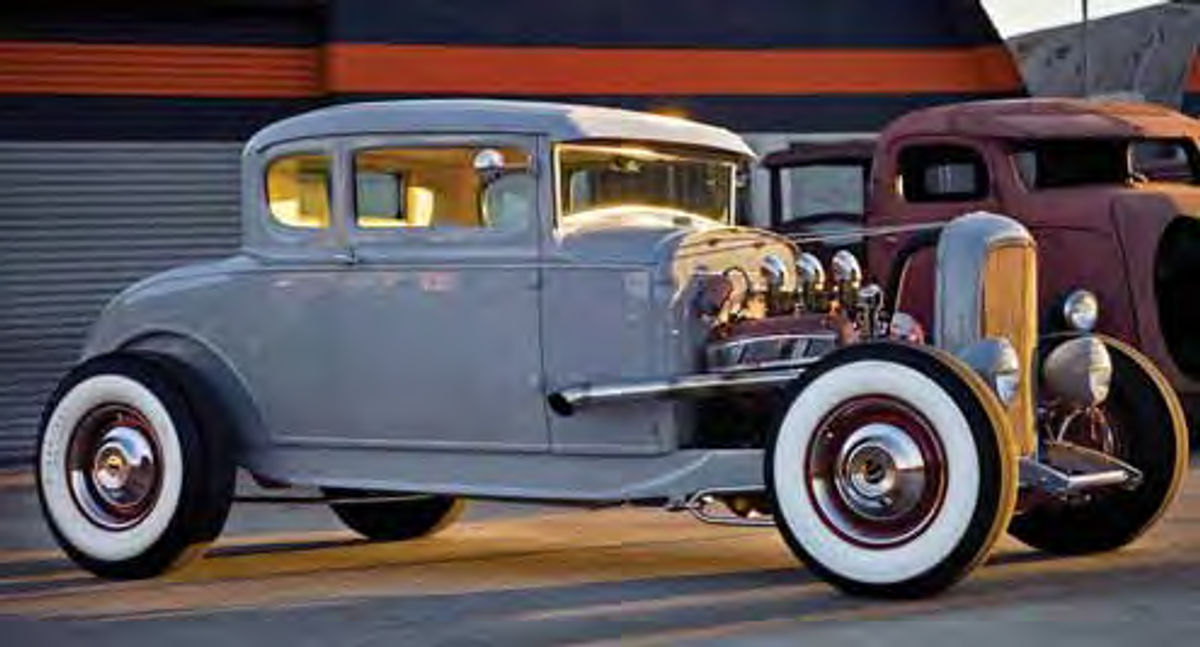1930 Model A Hot Rod Coupe
This Ford Has Been Immensely Popular as a Family Car & a Rod. Today, It Still Can Warm Hearts and Burn Rubber.
THE MODEL A Ford is as American as a slice of grandma’s apple pie. It’s also as American as Uncle Jack’s tattooed right bicep. Rarely does any automobile reach iconic status once, yet this little Ford has done it twice.
Partisans of the original Model A love the car because it embodies a near-perfect mix of handsome styling, mechanical simplicity and overall economy. It was the automotive equivalent of the square meal— tasty and hearty and enjoyed by nearly everyone.
Furthermore, as the years passed by, Model A Fords remained on the roads in great numbers partly because owners expected to get their money’s worth out of them, partly because the car was reliable and easy to repair, and partly because the Depression had sucked the average family’s financial resources nearly dry, making a new car purchase all but an impossibility.
The Start of Something Different
Loyalty to the Model A, built from 1928 through 1931, was well-established during the ’30s and even into the ’40s as it served many folks ably in the used car market.
So, by the time the U.S. had survived the Depression and World War II, the wrecking yards were loaded with dirt cheap Model A Fords. New and used parts were plentiful.
It was a set of circumstances made to order for teenagers and young adults looking for their own set of affordable wheels. It’s easy to understand how in many cases, ideas about how these cars should look and drive were unconventional and highly personalized, to say the least. With that, a powerful trend had begun, and hot rodding has been with us ever since.
The Model A wasn’t the only car that was made into hot rods, but it was arguably the most popular during the early years. For one thing, as noted above, there were four years’ worth of them and during that time only small changes were made. The 1928s and ’29s are virtually identical. Subtle differences distinguish the ’30s and the ’31s from the first two model years. Not surprisingly, it takes a trained eye to look at all four model years and place them in the correct order. And what four years of Ford parts interchangeability did not cover, mechanics’ ingenuity did. In other words, the Model A was on its way to becoming an icon for the second time.

Rodding’s Roots Return
Hot rodding has gone down many roads in the past 50 or 60 years, but a return to the roots of the hobby has occurred in more recent times. More cars are being built on a budget and in the ’50s style. That means scavenging parts and fabricating solutions. It’s possible to build a hot-rod-in-a-box project with a reproduction body, chassis and a brand new crate engine, but not everyone has the same ideas or the same amount of money to devote to the hot rod.
“I was looking at the money thing,” says Matt Giarratano, owner and principle builder of the 1930 Model A coupe in this Auto Restorer feature. “I had a $15,000 budget in mind when I started thinking about this car, but I ended up spending $18,000 to $20,000.”
A lot of people are spending two or three times that amount (and a lot more, too) to buy hot rods without turning a wrench. Giarratano cost control methods had a lot to do with his own labor and a willingness to take on a project. Getting a little help from a friend or two came in handy as well.
A Call to Be Creative
One benefit to building a hot rod is that you get to be the automotive designer and engineer, too. In the case of a Model A hot rod, you are unlikely to be following many of the plans laid out by Henry or Edsel Ford. You chart your own course borrowing ideas from a variety of sources and including a lot of your own notions.
“I really like the A-bone (a name associated with Model A hot rods),” Giarratano says. “To me, they look more raw. They look more like a hot rod. If you look at the old books and magazines, you’ll see a lot of old hot rods are ’32s, but there were a lot of ’30 coupe hot rods as well.”
A-bones (also known as A-bombs) get their character from the Model A—in this case, it’s the five-window coupe—but much of what goes into a hot rod comes from a variety of sources. You could call it makeshift. You could call it innovative. It’s one guy’s vision of what he wants his car to be and it comes from the flip side of off-the-shelf manufacturing. Most importantly, it comes from many hours of work in the garage and the combined skills to make it look good and run right.
A Better Price…and the Right Car
The idea to build a ’50s-style hot rod started to take shape in Giarratano mind in 2002. His plan was to start with a Model A coupe and go from there. In the early days of his search, he turned up leads on rusty, mistreated, fractured and mangled Model A candidates that were rejected for all the obvious reasons. As with all things involving a car project, patience is a virtue and the payoff for Giarratano came in the form of a classified ad. The owner of this coupe had run out of patience during his attempt to restore it and the realization that his project car was a monkey on his back finally forced him into a must-sell decision.
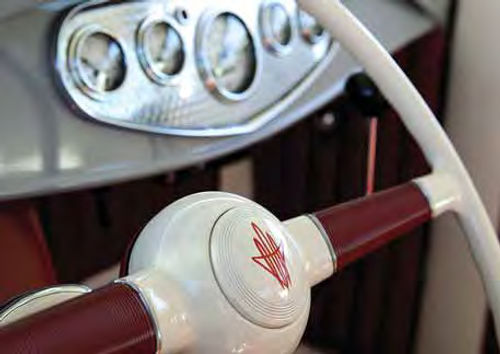
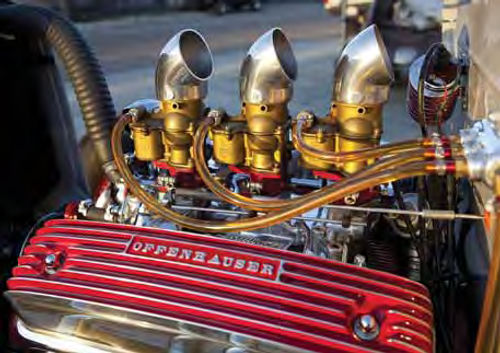
The asking price was $7500 and it included lots of extra parts, says Giarratano, a man of considerable negotiating prowess and a budget to guide his purchase. He worked the price down to $5500 and still walked away from closing the deal because all he really wanted was the coupe body, not all the extras. Fortunately for him, the seller had no other prospects, and when Giarratano went back to him a few weeks later, he came to a $3500 agreement for the entire package.
That’s a very good price for a practically rust-free coupe that had been primered, covered with a tarp, and kept in a storage facility. After he lifted the body from the frame, he sold everything else he had purchased for $2500. It was a very good start.
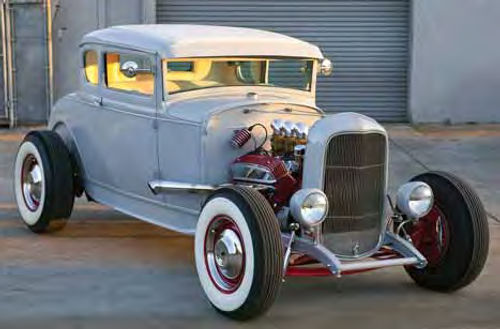
Time for Intensive Metal Work
Traditional restoration folks will groan, but the next bit of business was to chop the top, unknown territory for Giarratano, but not a deterrent.
It was a radical surgery and the roofline was lowered four inches. Because the roof pillars transition from skinny to fat, metal has to be stretched, opened up, filled, and welded so that everything aligns.
It was a radical surgery and the roofline was lowered four inches. Because the roof pillars transition from skinny to fat, metal has to be stretched, opened up, filled, and welded so that everything aligns
But then, the chopped top wasn’t the only metalwork Giarratano handled.
In a stock Model A, the gas tank is located inside the cowl area between the firewall and the dash panel. The gasoline filler cap sits in the center of the cowl just inches in front of the windshield. The firewall in a stock Model A has a bulge that protrudes into the engine compartment, so Giarratano cut the firewall out and reversed it so the bulge in the firewall protrudes toward the coupe’s interior instead of the engine compartment. He had already removed the gas tank from its original location and relocated it in the trunk.
Then he fabricated a new firewall and welded it in place in front of the original firewall (now reversed).
The new firewall is flush with the front edge of the cowl. So now the car has two firewalls with about two inches between them. The idea was to add strength and it also provided a little extra room for the engine.
A Free Engine From a Friend
Like the creative fires that burn in the minds of many hot rod builders, this project car was kindled by unexpected sparks. The engine is a good example. Rather than choosing a motor that you might expect to see—such as a small block Chevy or maybe a flathead V-8 Ford—Giarratano went with something quite uncommon.
His first thoughts took him in the direction of a Buick Nailhead, then he considered a Chevy 283. But then fate stepped in when a buddy who was selling a 1957 Ford one-ton pickup found a buyer who didn’t want the original engine.
“At first I didn’t want it, but now I’m glad I took it,” Giarratano says. “The engine gets a lot of attention in my car.”
It’s a Ford Y-block with a 292-cubic inch displacement—an engine that powered Ford trucks and cars.
The Y-block, introduced in 1954, was Ford’s first overhead valve engine. It replaced the side-valve Ford Flathead that dated back to 1932. The first Y-blocks were built with 239-cubic-inch displacement in Ford cars and trucks and a 256- cubic-inch displacement in Mercurys. One year later, the engines grew to 272 and 292 cubic inches. The 292 was used in the new-for-1955 Thunderbirds, Mercurys, and a limited number of high-end Ford cars, as well as some Ford trucks. Most Ford cars were outfitted with the 272. Ford cars continued to offer the 292 until 1961 and they were used in Ford trucks until 1964. The other Ford Y Block that Ford fans are familiar with is the 312. Most people would not be able to distinguish the 312 from the 292 from outward appearances. The Lincoln Division of Ford Motor Company had its own Y-block engines.
When Giarratano closely examined his Y-block (For more on the 292/312, see page 4.), the heads were cracked so he replaced them with heads from a 312, which bolt on without a problem. As the engine detailing took shape, the heads were crowned with finned Offenhauser cast aluminum valve covers—reproductions of vintage speed equipment.
As a bit of background, the Y-block got its name because of the distinctive deep-skirted design of the crankcase that extends below the centerline of the crankshaft. It’s a heavy-duty engine that, according to many sources, is beefy enough to allow the cylinders to be bored up to 0.120 inches without problems. However, Giarratano cylinders didn’t need to be bored. One cracked piston was replaced, and all the pistons got new rings, but that was the extent of it.
Full-Time Tri-Power
To complement the distinctive Y-block, Giarratano went with a three-deuces (tripower) fuel delivery system, a favorite setup of 1950s hot rod builders. Most people would automatically guess the carbs are Stromberg 97s, and they’d be wrong. These are Holley 94s, which are the standard two-barrel units that were used on millions of Fords from 1938 to 1957.
The Stromberg 97 and the Holley 94 are similar in appearance. They have the same three-bolt mounting pattern for one thing. In a side-by-side comparison, you’d notice the 94s have the fuel inlet in the top of the float bowl, while the 97s are designed with the fuel inlet in the side of the bowl. You’ll also find the Holley 94s have a center-hung float rather than the side-hung float that’s used on the Stromberg 97s. But compared to the Strombergs, the Holleys are much easier to find and less expensive to purchase.
Giarratano set up his three deuces to be active all the time rather than use the progressive linkage that allows a single carburetor to function until a heavy foot on the accelerator causes the second carb to kick in, and at full throttle the third carb joins the other two. He says he prefers his method because it is less finicky and it avoids the bog that is often experienced with a progressive linkage when you really get on it. His set-up uses a synchronizer with a float bowl and by adjusting the float bowls to be equal at idle, the fuel delivery remains smooth through acceleration.
However, he says, with three carburetors running all the time and the car idling for an extended time, he needs to “get on the pedal and blow it out” or it will foul the plugs.
An Edelbrock 3x2 intake manifold, purchased at a swap meet, replaced the stock manifold. Reproductions are available, although this isn’t one of them.
The exhaust headers are aftermarket from Sanderson, and Giarratano modified them by stuffing glass-pack mufflers inside along with four baffles made from screen and welded in place behind each glass pack. Although it still sounds like a hot rod, it runs much quieter than if the straight pipes were unmuffled. At the ends of the straight pipes, there are 60- degree cutouts which Giarratano fashioned from Peterbilt truck exhausts.
A New Frame and Floor
Ahead of the engine is a reproduction ’32 Ford radiator shell from Vintique, a less expensive alternative to the real McCoy.
An aftermarket ’32 Ford frame from American Stamping provides the hot rod’s foundation. It was pinched in front to accommodate the narrower Model A body. Giarratano planned it so the body sits on top of the frame, a style the hot rodders refer to as a highboy.
To get the look he wanted and to match the body to the frame, Giarratano cut out the floor—not only in the passenger area but throughout the car. He then built a new floor on top of the humped frame. A flat frame made specifically for Model A bodies is available now, but wasn’t being made when Giarratano built his rod.
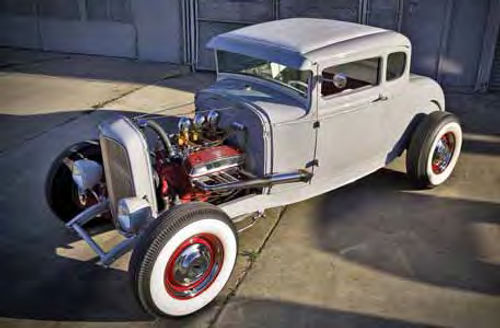
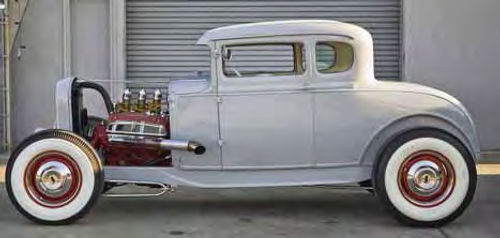
To achieve the right stance, the frame has a modest kick-up in the back and Giarratano raised the body up a bit more using the shocks.
“I had to have the right look,” he says. “I want it looking like it’s diving down a little bit.”
It’s all part of the hot rodder vision that factors into features like the 4-inch chopped top; the fenderless body, the drop axle up front, and the Y-block sitting naked in the breeze.
Giarratano fabricated new motor mounts and transmission mounts so the engine and transmission would fit the frame. The transmission, by the way, is a Ford C-4, a three-speed automatic produced from 1964 through 1986. Compared to the older cast iron Cruise-O-Matic transmissions, the C-4 is much lighter, due primarily to its three-piece aluminum alloy case that includes the bell housing, main case and tailhousing.
A Stealth Front Brake System
Reproduction parts play a big role in the front end suspension. This isn’t the ’40 Ford straight-axle front end that a lot of guys used on rods that were built in the 1950s. Back in the day, the common method of dropping the front end was to heat the axle and bend it. This is an off the-shelf Super Bell classic I-beam front axle with a four-inch drop. It still makes use of a transverse-mounted leaf spring, which gives the car the old-school look.
The front brakes have the appearance of rare and expensive vintage Buick finned drum brakes, but these are reproductions available through SoCal Speed Shop. Inside of these are disc brakes, which add a real safety factor when mixing it up with modern traffic.
Modern technology also gets the nod when it comes to the steering box. Back in the day, rodders typically scavenged for donor boxes from ’40 Fords. Giarratano chose the Vega box, which he purchased from Speedway Motors, because it’s new technology that contributes to the overall safety of the vehicle.
Working on this car in his spare time, Giarratano—with some help from his friends—completed his project in less than two years. Along the way, he proved to himself that he can build a car to his own standards…instead of paying a shop and missing out on all that quality time in the garage as well.

